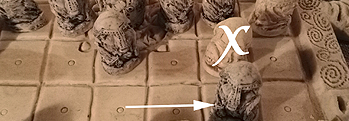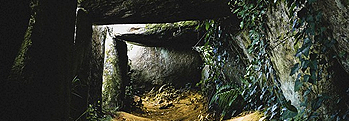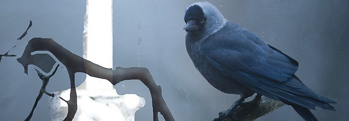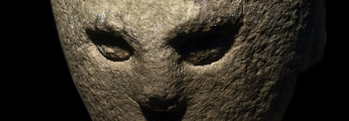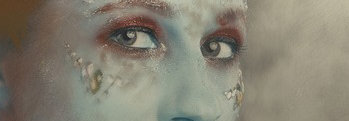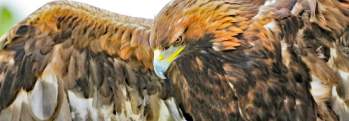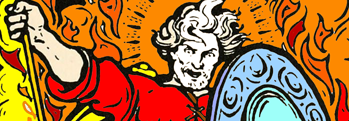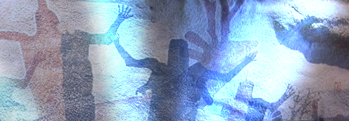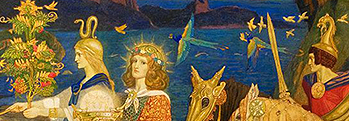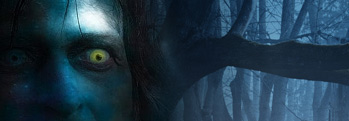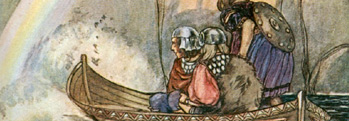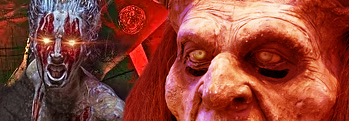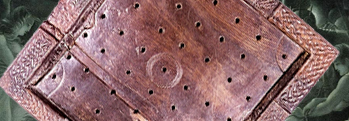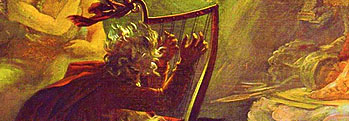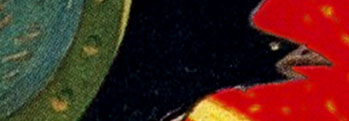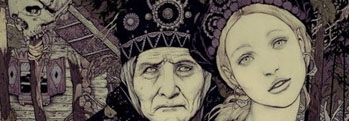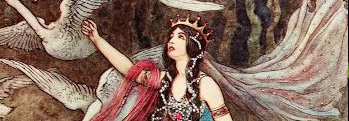Queen of the Banshees
Irish and Celtic myths and legends, Irish folklore and Irish fairy tales from the Mythological Cycle
A tragic beauty
 Her name was Clíona or Clíodhna and she was one of the most beautiful women of the Tuatha Dé Danann, that vanished sorcerous race whose legends echo still from one end of Ireland to the other. Some even say she was the most beautiful woman in the world, and she was worshipped as a goddess by the pagans of Ireland who followed the fall of the Tuatha.
Her name was Clíona or Clíodhna and she was one of the most beautiful women of the Tuatha Dé Danann, that vanished sorcerous race whose legends echo still from one end of Ireland to the other. Some even say she was the most beautiful woman in the world, and she was worshipped as a goddess by the pagans of Ireland who followed the fall of the Tuatha.
She was one of three daughters of Gebann, the chief druid of the sea-god Manannán Mac Lir, who had a particular fondness for her, much to her detriment, and was known for guarding against blighted crops and protecting animals, particularly cattle, from disease and from the evil eye. She was reputed to be able to change into a wren, as she did to escape one young mortal who had learned her magic, or a white hare.
She had three birds which ate from the fruit of a magical apple tree growing in Tír na nÓg, the Land of the Young, Tír Tairngire, the Land of Promise, and Magh Meall, the Pleasant Plain. Their bright song could sing anyone into a deep sleep which would heal all wounds, sicknesses and injuries.
Together with Aoibhell and Áine she was one of the three goddesses of Munster. She had a great rivalry with Aoibhell and both of the women fell in love with a young chieftain called O'Caoimh. His fancy was for Aoibhell though, and they were engaged to be married. Cliona called on the help of an old wise woman skilled in dark and twisting arts, and Aoibhell began to fade away.
Cliona told her she'd be cured if she renounced the love of O'Caoimh, but Aoibhell refused, so Cliona gave her a lash of a magic wand which turned her into a white cat. Later O'Caoimh, not knowing where his bride to be had vanished off to, agreed to marry Cliona, but the old wise woman confessed to her part in the crime, and gave him the wand to turn the cat back into a woman.
It was Cliona's turn to spend some time as a cat then, for when he heard the full story he tapped her with it and regained his bride in the next stroke!
She had many titles, among them Queen of the Banshees, for it was said she ruled those spirits who sent up a bone-chilling wail before a death among of one of the ancient families of Ireland. These were the sidheog, the fairy women of the hills, of South Munster, known as Cork and Kerry today.
Clíona would travel from her palace beneath Carraig Clíodhna, Clíona’s Rock, or send forth one of her sister-subjects when the shadow of death stretched its hand over the descendants of those who had worshipped her. It was said there was no morning of the year when Clíona wasn’t outside of that Carraig before sunrise, combing her long hair.
She was especially associated with the MacCarthys, FitzGeralds, O'Donovans, O'Collins, O'Keeffes and O'Learys, but in particular the O'Donovans who came south from Uí-Fidghente before Saint Patrick landed, abandoning their worship of the goddess Mongfind for the love of Clíona. In later times, Domhnall Ó Donnabháin was referred to as the "Dragon of Clíodhna".
Domhnall's son, dragon of Cliodhna, is guardian of the ancestral name,
he will remit his authority to none other - he has accepted the law of his dynasty.
O'Donovan, Four Masters, vol. V, p. 1548
Clíodhna’s Rock, anglicised as Carrigcleena, is a couple of hours walk southwest of Mallow in the parish of Kilshannig, and the nearby stone circle has a reputation as a “door to the Otherworld” where Clíona betimes leads her fairy women in slow dances under the waxing moon. Another rock, Carrigcleenamore, off Inch Strand, two miles south and east of Rosscarbery, is known by locals as the seat of this goddess and path to the underworld.
Her palace plays a central part in a story about a man called Seán Mac Séamas, an Irish prince. Bewitched by a beautiful stranger he met during a feast at his father’s hall, he bit a piece of apple she gave him before falling into a swoon.
Clíona took his prostrate figure and carried him away to the rock, trapping him within and inside the otherworld. In desperation he wrote a letter in blood, slipping it out of a crack and into the whipping wind, which carried to to a cowherd. Once the king heard about this, he sought the help of a wise woman, who went to the rock, and, waiting until Clíona was brushing her hair in the morning, grabbed a handful and twisted it painfully it in such a way that Clíona could not look at her, since her mother warned
“If she lays her eyes on you, you're finished!”
She refused to release Clíona until the young prince was freed, and so it was done.
She was also said to lure young men to their doom in the watery grave which claimed her mortal form – for she left the safety of her fairy country to pursue a young man called Ciabhán of the curling locks, but Manannán Mac Lir grew jealous! So while her lover was away hunting, she rested her head on the strand Trá Théite at Cuan Dor or Glandore, the Harbour of the Oak Trees, between Skibbereen and Clonakilty.
Treacherous Manannán sent his mystical bard Iuchna to play magical music which put her into a far deeper sleep, and then she was drowned by a great wave! She swore a prophecy thereafter, that one day all of Munster would be swallowed by a terrible wave. And to this very day, every ninth wave, the strongest, or any particularly loud wave in the area is called “Tonn Clíona”, or Clíona’s Tide.
Fishermen in Cork still think it’s bad luck to see a woman on the shore before you set out to sea.
Nor was her power forgotten until long after the Christianisation of Ireland! For it was Fat Cormac McCarthy who ran into legal trouble while building his castle at Blarney in the fifteenth century, and he beseeched the ancient power for help.
She appeared to him, kissed his lips, and told him to kiss the first stone he he found in the morning on his way to court. As a result, he pled his case with great eloquence and won, finishing his castle shortly after that. Thus the Blarney Stone is said to grant "the ability to deceive without offending", and Cormac was so pleased that he had the stone built into the wall at Blarney Castle, where countless numbers people visit every year to kiss the stone and get Clíona’s gift for themselves.
So powerful were its effects that even Queen Elizabeth said in frustration that she could not complete a negotiation with Cormac MacCarthy and get her hands on his seat at Blarney Castle, since everything he said was “Blarney, as what he says he does not mean”!
Some stories about Clíona show her as dark and sinister, a dangerous and fatal figure, while others speak of her love and kindness, which may be why she remains so fascinating to this day. Among those who took a special interest in her were Irish revolutionary Michael Collins, who hear about her in the Rosscarbery school he attended and they took Sunday trips to Clíodhna's rock. Here, according to Michael's friend Piaras Béaslaí
Michael heard many a wonderful tale of Clíodhna's enchantments, of wrecks and perils, and drownings and treasure trove.
Collins was descended from the Ó Coileáins of Uí Chonaill Gabra. Both the Uí Chonaill and the Uí Donnobhans were tribes within the Uí-Fidghente, and some have wondered whether that great son of Ireland heard the mournful song of the banshee before his fateful last day!
One midsummer's eve, when the Bel-fires were lighted,
And the bagpiper's tone call'd the maidens delighted,
I join'd a gay group by the Araglin's water,
And danced till the dawn with O'Donovan's Daughter.
Have you seen the ripe monadan glisten in Kerry,
Have you mark'd on the Galteys the black whortleberry,
Or ceanabhan wave by the wells of Blackwater?
They're the cheek, eye, and neck of O'Donovan's Daughter.
Have you seen a gay kidling on Claragh's round mountain,
The swan's arching glory on Sheeling's blue fountain,
Heard a weird woman chant what the fairy choir taught her?
They've the step, grace, and tone of O'Donovan's Daughter!
Have you marked in its flight the black wing of the raven,
The rosebuds that breathe in the summer breeze waven,
The pearls that lie hid under Lene's magic water?
They're the teeth, lip, and hair of O'Donovan's Daughter!
Ere the Bel-fire was dimmed or the dancers departed,
I taught her a song of some maid broken-hearted:
And that group, and that dance, and that love-song I taught her
Haunt my slumbers at night with O'Donovan's Daughter.
God grant, 'tis no fay from Cnoc-Firinn that woos me,
God grant, 'tis not Cliodhna the queen that pursues me,
That my soul lost and lone has no witchery wrought her,
While I dream of dark groves and O'Donovan's Daughter.
If, spell-bound, I pine with an airy disorder,
Saint Gobnate has sway over Musgry's wide border;
She'll scare from my couch, when with prayer I've besought her.
That bright airy sprite like O'Donovan's Daughter.
Edward Walsh
Carraig Clíodhna is marked on the map below!
More Stories from the Mythological Cycle
We are delighted to be able to present to you the rules of Fidchell, the Irish game of kings! This game can be purchased, but it's easy to get started and try it out for yourself. All you need is a 7 x 7 board, which can be squares or pins marked out - even on paper - 16 white or attacker pieces, a king piece, and 8 darker-coloured defender pie ... [more]
Times were hard in Ireland not so long ago, and harder yet they were before that – many’s the family was cast out of their houses for being unable to pay their rent! One such was poor Finian O’Toole, the kindly father of nine children who found himself evicted by the cruel English landlord in the parish of Kilmoe. Now it was th ... [more]
There is a tale, one of the oldest stories among the many very ancient stories of Ireland, of a man who returned to life as a man thousands of years after he first walked the earth. His legend was found in an eleventh century manuscript called Lebor na hUidre, which means The Book of Dun Cow, and it was written there by the followers of an early ... [more]
It’s a not uncommon belief that the women of Ireland in the ancient days were quiet and kept to themselves, letting the men do all the great deeds and win all the fame – but nothing could be further from the truth! From that day to this Irish women were and remain wild and fearless, willing to go to lengths as great as any man for victo ... [more]
Of great renown are the feats and deeds of the ancient heroes of Ireland, and still to this day they echo through our legends where such tales are told. But of scarce less fame were the weapons they bore, implements of glory and terror, bound to ancient spirits and clasping lightning within their shimmering length, wielded with scarcely imaginable ... [more]
The Tuatha De Danans By the force of potent spells and wicked magic, And conjurations horrible to hear, Could set the ministers of hell at work, And raise a slaughtered army from the earth, And make them live, and breathe, and fight again. So it was written in Keating's General History of Ireland, considered by many to be the definitive ... [more]
Her name was Clíona or Clíodhna and she was one of the most beautiful women of the Tuatha Dé Danann, that vanished sorcerous race whose legends echo still from one end of Ireland to the other. Some even say she was the most beautiful woman in the world, and she was worshipped as a goddess by the pagans of Ireland who followed t ... [more]
Many are the tales told of Lugh, the mightiest king of that ancient and mystical sorcerer race of Ireland, the Tuatha Dé Danann, but only one is told of his death. Now Lugh, lord of many warriors, had four wives, which back in those days wasn’t too unusual, and their names were Echtach, daughter of white-toothed Dagda, Englec, Ná ... [more]
Just as happens today, people in ancient Ireland had legal disputes and complaints they would bring before their courts, and the judge or king would try to make sense of what had happened and hand down a fair decision. But also just as happens today, there were situations where it was one person’s word against another, or there wasn’ ... [more]
The old stories of Ireland, some of the oldest in the world, tell of great ancients – almost immortals! – whose span of life stretched many thousands of years. Legends tell of their spirits passing from one body to the next, or upon occasion, staying in the one body for millennia, watching the tides of man and beast come and go. Such ... [more]
One of the chiefest and most powerful kings among the mystical Tuatha Dé Dannan was the one called Dagda, or Dagda Mór, which means “of shining skills”. He had other names too, such as Eochu the horseman, Ruad Rofhessa, lord of great knowledge, Dáire the fertile one and Aed, he of the fiery temper. Others yet called ... [more]
The Irish Brehon law codes are said to be the earliest fully developed legal system in Europe, but long before the Brehons were laid down there were earlier laws and all were subject to them, from the lowest to the highest! Women could hold their own property, were not themselves considered property, and could seek an education and improve their ... [more]
No tale of ancient Ireland could be complete without mentioning the Fomorians, dreaded foes of the Tuatha Dé Danann and all who came to conquer Ireland. The meaning of their name is debated even today, although most agree that the first part, fó, means “from below” or “nether” and the latter part means “t ... [more]
Many of the oldest records of Irish mythology and legend, which you might truthfully say are a history of prehistory, tell that the first people to arrive in Ireland were led by the lady Cessair when she fled to this land to escape the coming flood. The idols which had whispered through veils of midnight smoke that Ireland was a land untouched by p ... [more]
Throughout the old stories of Ireland are scattered mentions, and sometimes even descriptions, of some of the spells and rites used by both the Tuatha Dé Danann and those who came after them, the Gaels or Milesians, as they are sometimes known. Tales of these wondrous and mysterious feats of sorcerous skill may seem strange to us, but to the ... [more]
It was a warm and balmy summer's night, heavy with the fragrances of heather and honeysuckle, when Aengus, son of Dagda, awoke to find a beautiful young woman approaching him where he had slept. He was immediately taken with her grace and elegance, and his heart yearned for her, but when he tried to speak, she vanished! He stayed in his bed ... [more]
The river Barrow, like many rivers in Ireland, was given its name in ancient times. Few now know it once had another and very different name however, for it was when Dian Cécht walked the world, the healer of the Tuatha De Danann, that this river was first named! Dian Cécht, whose name meant swift power or swift potion, depending o ... [more]
A thousand years before the Olympic games were founded, the Tuatha De Dannan had arrived in Ireland and defeated the Fir Bolg, establishing their place on the Emerald Isle. The mighty queen Tailtiu had married Eochaid mac Eirc of the Fir Bolg, but he was killed during the invasion of Ireland by the Tuatha, so the leader of the invaders took her for ... [more]
In ancient times the Gaels would hold great festivals at different seasons of the year, such as the Tailteann Games, Tlachtga, Raigne and Lughnasadh, and it was at the beginning of August, every three years, that the festival of Carmun would be held during the festival of Lugh. Mighty were the celebrations held, with the racing of horses and the ... [more]
Long ago it was the time of the Tuatha De Danann in Ireland, and they were troubled by strife from beyond the Emerald Isle and within it. One of their mightiest warriors whose name was Lugh of the Long Hand heard that their demonic enemies from the sea, the Fomorians, had landed at Eas Dara, so he hopped up on Aonbharr, a horse which could gallop a ... [more]
Some of the most ancient Irish myths and legends tell of the Bocanachs and the Bananachs, known to the people of Ireland as fierce spirits of the air that were drawn to scenes of battle and bloodshed. Whenever armies gathered to test their might, the sky overhead would be filled with shrieking demons dancing to the sounds of swords clashing and blo ... [more]
Woven through many Irish stories, myths and legends is the ancient game of Fidchell, which means “wisdom of the wood”. It's said that it was invented by none other than Lugh of the Tuatha De Dannan, and predates chess by many centuries. Fidchell held a central role in the celebrations of Lugh, and at Samhain festivities as well, ... [more]
Well known is the ancient tale of the Children of Lir, and how two of the three of Bodb Dearg's daughters by Oilell of Aran married Lir to keep the peace in Ireland, between the rival chieftains of the Tuatha De Dannan. But less well known perhaps is the story of the daughter of the Bodb and one of her admirers, Cliach the Harpist. Cliach pl ... [more]
After the second battle of Moy Tura, Nuada the High King of the Tuatha De Danann was grievously injured, and as it was the law among their people that a king must be whole of body, Dagda Mór took his place. Mighty Dagda, of whom the ballads are sung, he was called the father of the Tuatha, the lord of knowledge, the many-skilled, th ... [more]
It is in the nature of fairytales and legends passed down from generation to generation that they might sometimes change and shift to fit the lives of the people of the time, and the more mysterious the figure the more legends accrue to it! And so it is with Donn of the Dead, king of the dead at the red tower of the dead, whose three sons cried &ld ... [more]
It was at the dawning of the world when the fair folk walked in broad daylight as bold as you and I, before the coming of the Milesians with their bitter iron blades and earthen ways, it was the time when magic was wrought and druidry had power, when heroes gave battle to gods and the titanic children of Seth still troubled the dreams of Heaven, it ... [more]
The raven has long been an omen of ill-tidings around the world, bearer of bad news and warnings, but in Ireland it was known once as a servant of the fairy Morrigan, or the raven was herself in person! She it was whose name meant the Great or Ghost Queen, from the old words for fear and greatness. Some will tell you earnestly that she was a god ... [more]
Long ago, in the time of the Tuatha Dé Dannan, one of their number became the high king of all Ireland, and his name was Eochaid Ollathair. He was a powerful magician of that sorcerous race, and by his workings he could change the weather and ensure the harvest was plentiful, as well as many other things. His wealth was vast and he was mu ... [more]
It was in the time of legends and heroes, when the Tuatha Dé Dannan had determined to go into their deep halls beneath the hills and mountains of Éireann the green, that the Dagda mór had fallen at the second battle of Moy Tura. With his slaying a new leader had to be elected and that was decided by the Tuatha to be the Red Cro ... [more]
And so it was when dragons still flew and champions walked the earth that the men of the Fir Bolg had lordship over all of Ireland. They had left Ireland centuries before due to the violence and heavy tribute demanded by the Fomorians, travelling far and wide until they came to the distant land of Greece. Although they made agreement and treaty ... [more]




